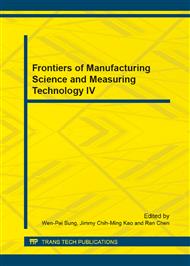p.489
p.493
p.499
p.503
p.507
p.511
p.517
p.522
p.526
The Nanocutting by Rigid/Elastic Tools with Nose Radius at the Gas Environment Using Molecular Dynamics Simulations
Abstract:
. This study successfully simulated the single crystal copper nanocutting by a rigid body /elastic tools with nose radius at the nitrogen gas environment using molecular dynamics, and analyzed the workpiece temperature distribution and dislocation during nanocutting. After simulations, it can be found that when cutting with the elastic body tool, the tool itself was still distorted slightly, however, the cutting results of the elastic tool and the rigid body tool of the tool are not the same. The chip temperature was highest near the central rake and nose.The workpiece temperature when the elastic body tool cutting was lower; the temperature in the nose and rake plane is the highest, the more away from the nose, the lower the temperature.
Info:
Periodical:
Pages:
507-510
Citation:
Online since:
August 2014
Authors:
Keywords:
Price:
Сopyright:
© 2014 Trans Tech Publications Ltd. All Rights Reserved
Share:
Citation:


